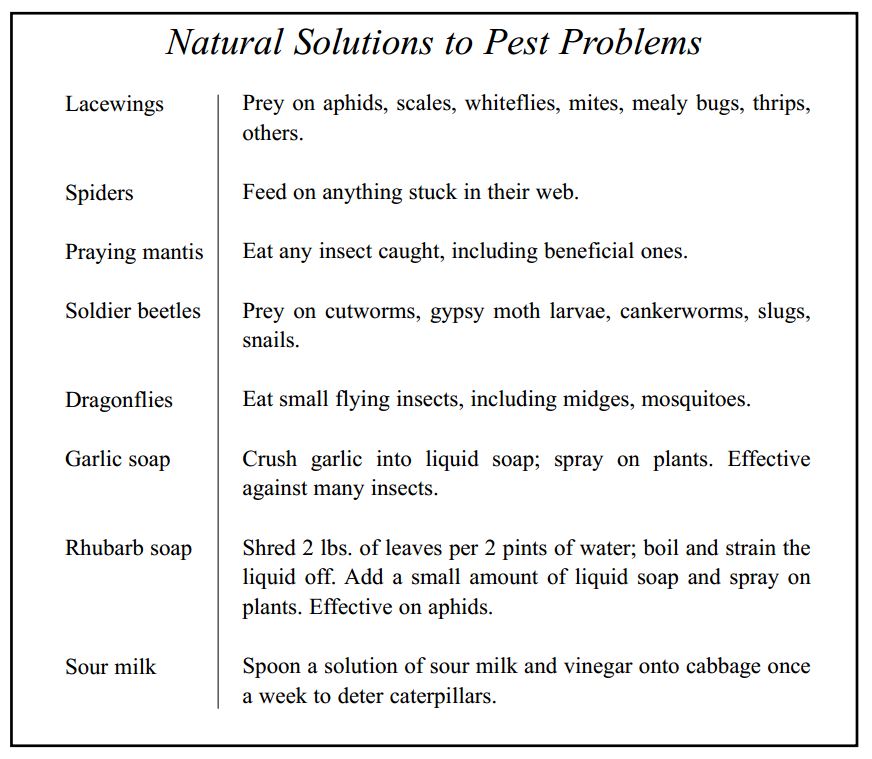Underneath it all, most of us are driven by some deeply hidden desire to dominate nature.
And this human tendency to control and manage things out there has been picked up by industry and the media. Like the false need created for the regular use of lawn fertilizers, pesticides are yet another byproduct of the almighty petroleum industry, whose messages continue to dominate consumer advertising. Although dim voices in the background have been telling us that pesticides are a commercial hoax, and probably a dangerous one, breaking the pesticide barrier and changing human behavior isn’t easy.
Perhaps the best way to begin is to ask some soul-searching questions: What pest are we trying to control, and why? Is the pest causing real damage or just making some ugly holes and marks on otherwise good-looking leaves? Is this particular tree or shrub or stand of grass doing poorly because of a bug, or might it not really belong in this yard in the first place? It just may be that the plant or shrub in question is not the best choice for the landscape, given soil and climate conditions. And we might discover after a little research that a better choice exists—perhaps a native species or even a new, pest-resistant hybrid.
The BayScaping page provides species lists of shrubs, trees, and grasses that are native to the region, and therefore have been adapting to natural challenges here for hundreds of years. These alternative selections are a great place to start, particularly if you’re tired of picking and spraying and don’t feel right about introducing all these harmful chemicals into your landscape. Even well-researched and thought-out decisions that result in purchasing a non-native species can be applauded if the choice is a strong hybrid, resistant to disease and drought. Just make sure it’s not going to take over other vegetation—what’s called “invasive.”
In situations where you feel compelled to battle a pest, consider first using an organic-based product. The list of affordable, effective organic pesticides continues to grow. If you don’t know where to get them, contact your local cooperative extension office. For a great continuing education, get a copy of Organic Gardening, published by Rodale Press. It is full of terrific, useful information, with a list of commonly used organic controls—and their targets—that is regularly revised.

In flower plots and vegetable gardens, you might consider introducing some beneficial insects, animals, and plants. Ladybugs, praying mantis, toads, and marigolds are commonly used to naturally fight pesky slugs, mites, aphids, and beetles, just to name a few victims. Use them as your “ground attack force,” and let the indigenous bat population clear the air of mosquitoes and other nasty flying insects.
The use of organics and other non-toxic products is nicely incorporated as one component of Integrated Pest Management, or IPM. Farmers on the Neck are quite familiar with its tenets. They’ve been practicing IPM for years. Residential property owners are quickly climbing aboard. IPM advocates using the least harmful approach to pest management, and reverting to a chemical solution only when absolutely necessary.
The need to reduce pesticide use on the Northern Neck is apparent, given the natural topography, soils, and surrounding water. Pesticides can end up in groundwater and local creeks, causing tremendous harm to the fish, animals, and plants living there.

Natural Solutions to Pest Problems
Lacewings: Prey on aphids, scales, whiteflies, mites, mealy bugs, thrips, others.
Spiders: Feed on anything stuck in their web.
Praying mantis: Eat any insect caught, including beneficial ones.
Soldier beetles: Prey on cutworms, gypsy moth larvae, cankerworms, slugs, snails.
Dragonflies: Eat small flying insects, including midges, mosquitoes.
Garlic soap: Crush garlic into liquid soap; spray on plants. Effective against many insects.
Rhubarb soap: Shred 2 lbs. of leaves per 2 pints of water; boil and strain the liquid off. Add a small amount of liquid soap and spray on plants. Effective on aphids.
Sour milk: Spoon a solution of sour milk and vinegar onto cabbage once a week to deter caterpillars.
